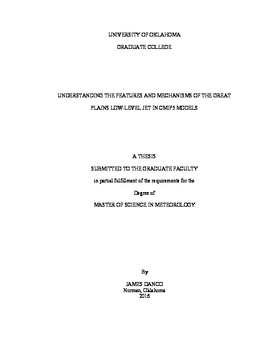| dc.description.abstract | The Great Plains low-level jet (GPLLJ) is an important driver of precipitation and severe weather outbreaks over the U.S. Great Plains during the spring and summer. Therefore, it is extremely important that features of the GPLLJ, including its atmospheric and oceanic mechanisms, are understood and simulated accurately by global climate models so Great Plains precipitation can be predicted reliably in the future. This study examines the features of the GPLLJ and the mechanisms relating it to the El Niño Southern Oscillation (ENSO) in reanalyzes and global climate models, to aid near- and long-term predictions and projections of Great Plains weather and climate. Sea surface temperature data, four reanalyzes, and an ensemble of 42 historical simulations from phase 5 of the Coupled Model Intercomparison Project (CMIP5) are used. This makes this study the first of its kind to examine the ability of the entire suite of CMIP5 models to represent the observed features of the GPLLJ and its relationship with ENSO. Biases in the CMIP5 model simulation of the climatology of the GPLLJ are identified, including a GPLLJ that is too weak, extends too late in the summer, and peaks too low in the troposphere. Noting these biases, the accuracy of the ENSO - GPLLJ relationship in the CMIP5 models is investigated. As in previous studies, observations and reanalysis show that winter ENSO has a significant negative correlation with the GPLLJ in the following spring and a significant positive correlation with the GPLLJ in the following summer. This study illustrates that the influence of ENSO on the GPLLJ is mainly on the frequency, not intensity, of GPLLJ events in the spring, while both the frequency and intensity of GPLLJ events are affected in the summer. However, although the majority of CMIP5 historical simulations (82 out of 131 ensemble members) exhibit the observed significant negative ENSO - GPLLJ correlations in the spring, nearly all of them (129 out of 131 ensemble members) fail to simulate the significant positive correlation in the summer. The ability of the models to simulate the ENSO - GPLLJ relationship is attributed to the strength of simulated ENSO events and the associated effects on geopotential heights and atmospheric circulation. These results have implications for the predictability of climate in the Great Plains and suggest that the variability of the GPLLJ will not be reliably captured in future climate simulations if the magnitude of ENSO events and their impacts are not well represented. | en_US |
